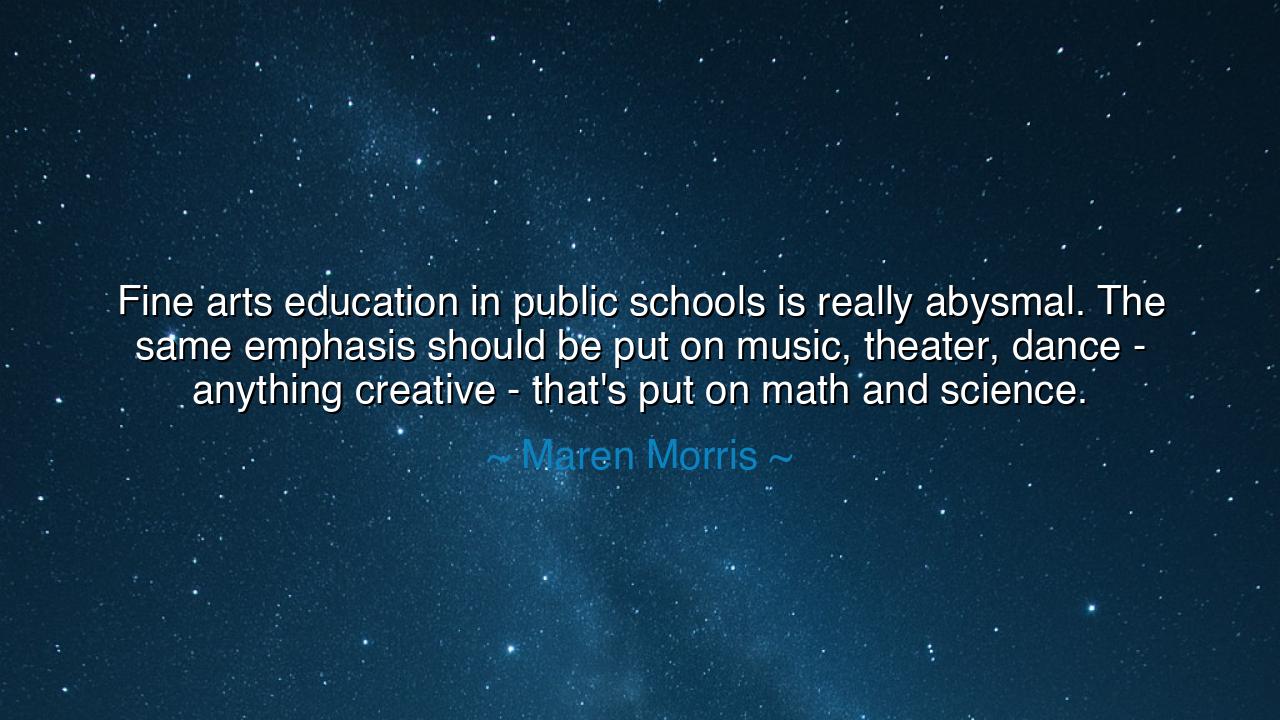
Fine arts education in public schools is really abysmal. The same
Fine arts education in public schools is really abysmal. The same emphasis should be put on music, theater, dance - anything creative - that's put on math and science.






In the words of Maren Morris: “Fine arts education in public schools is really abysmal. The same emphasis should be put on music, theater, dance—anything creative—that’s put on math and science.” These words, though spoken in our own age, carry the weight of an eternal truth. For a people who nourish only the mind with numbers and laws, yet starve the soul of song, movement, and vision, raise generations who can build machines but forget why they were built. A civilization without art is like a body without breath—alive in form, but dead in spirit.
The ancients knew this balance well. Among the Greeks, it was not enough for a youth to master logic and philosophy; they were also trained in the lyre, the chorus, the dance of the body, for they believed the harmonious soul is shaped by both order and beauty. In China, the scholars of old were not deemed complete unless they could compose poetry, paint rivers and mountains, and move with grace in calligraphy. The great cultures of the past understood that knowledge without creativity is a blade without a hilt—sharp, but dangerous, lacking the hand that wields it with wisdom.
History reveals what happens when the arts are ignored. In the early years of the Industrial Revolution, children were taught to labor in factories, their days measured by the turn of machines. Numbers and output were praised, but the spirit of those generations grew weary, gray, and voiceless. Yet from this darkness arose voices who reminded the world of beauty—poets like William Blake, who saw angels in the streets of London, and musicians who composed hymns that lifted the soul above the smoke of the mills. Their existence reminds us that the creative spark is not an ornament to life, but its lifeblood.
Consider also the story of Beethoven, who, though deaf in his later years, poured out symphonies that continue to echo through centuries. Had his education been only in arithmetic, his genius might never have found its voice. Yet because he was nurtured in music, he left humanity treasures more enduring than empires. This is the power of fine arts: to give the voiceless a tongue, the broken a song, the weary a vision of what might be.
Maren Morris speaks truth when she calls our present education abysmal in this regard. We raise children to solve equations but not to write poems; to memorize formulas but not to paint their dreams. Yet a society that does not value its artists is a society that forgets how to feel. And what is a nation without feeling? A cold edifice of achievement, perhaps strong, but hollow—lacking the warmth that binds hearts together.
The lesson is thus: let us give equal honor to the realms of imagination and reason. For math and science teach us the laws of the universe, but art teaches us the meaning of being alive within it. One reveals the structure of existence, the other, its beauty. To neglect either is to walk with one eye closed. To embrace both is to see with the full vision of the human spirit.
Therefore, O listener, take this teaching into your own life. Do not neglect the creative within you. If you are a parent, give your child the gift of music, theater, or dance, as much as the gift of books and numbers. If you are a leader, fight for schools that cultivate not only intellect, but imagination. And if you are a seeker of wisdom, remember always to balance logic with lyric, structure with song, the measurable with the mysterious. For only then will your soul be whole, and your generation truly flourish.






AAdministratorAdministrator
Welcome, honored guests. Please leave a comment, we will respond soon